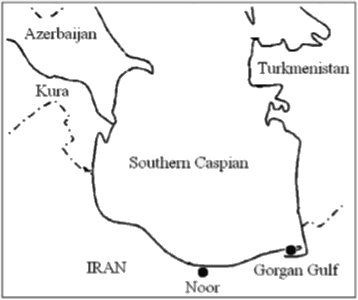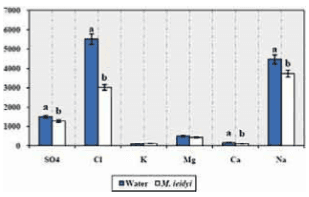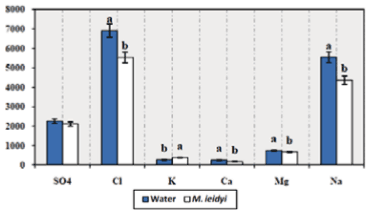Introduction
Ctenophora, a phylum of animal kingdom, is obiquoitous. Mnemiopsis leidyi is one of the species of comb-jelly belongs to Ctenphora phylum. The main habitat of this ctenophore is the east coast of North and South America, which covers the Atlantic coastal zone from latitude 40° North to 46° South (Harbison and Volovik, 1994). The introduction of this species into the Caspian Sea in December 1999 (Esmaili Sari et al., 2001) and must adopt to new conditions of caspian sea which it seems to radically has affected the whole ecosystem up to now. It is a voracious predator on zooplankton (including meroplankton, the larvae of benthic animals), fish eggs and fish larvae, so that within two years, an almost 50% decrease in the kilka catches of Iranian fishermen occurred (Kideys et al., 2001).
The internal osmotic pressure of osmoconformers, including most invertebrates is approximately equal to the external osmotic pressure of sea water, whereas osmoregulators maintain relatively constant internal osmotic pressure over a range of environmental salinities (Hill and Wyse, 1989). Ionic regulation is done in all animals, including osmoconformers and osmoregulators (Jurd, 2000). Considering the differences between body inside and environment, maintaining ions and fluid in proper concentration is necessary to save the life.
The lack of information about osmotic regulation in ctenophores may be due to the simplicity of this animal body in which water constitutes most of its volume. Therefore, assumed to be an osmoconformer like most marine invertebrates. It can be also due to the lack of suitable method for the extraction of body fluid from these animals. Mills, (1984) studied on the ability of osmoregulation only in the largest surveyed species, Aequorea victoria (Hydromedusae) and hypothesized that the other species like A. victoria were also osmoconformers. M. leidyi as an invader species of the Ctenophora phylum is compatible with different salinities. Hence, it is important to carry out a separate study on osmotic regulation and ionic composition of this animal. Till now, even a single study has not been done on Ctenophora ionic regulation (Ruppert et al., 2004).The regulation of osmotic pressure in aquatics plays an important role in adaptation to environmental condition. Creatures who could not adopt to the osmolarity of environment must expense large amount of energy to regulate the available ions.
Cl, Na, K, Ca, Mg and SO4 ions play major role in regulation of osmotic pressure. In addition to these ions, proteins of internal fluid also involved in this process (Mills and Vogt, 1984). With regard to the existing ability of M. leidyi in different water resources with the wide range of the salinity changes, the study on the osmotic and ionic regulation mechanisms seems necessary not only as one of the main physiological factors but also knowledge about the osmotic abilities of this animal in new environments. In this investigation, biological aspects, concentration of Cl, Na, K, Ca, Mg, SO4, osmotic pressure inside and outside ions inside and outside of the body were calculated.
Materials and methods
Sampling:
The study was conducted during summer and autumn of 2008 in southern shores of Caspian sea (Fig. 1). The sampling was executed in two different locations as follows:
First Location: Southern shores of Caspian sea in Noor area from 20 meter depth. Second Location: Gorgan bay (South–East of Caspian sea) from 4 meter depth. The final sampling was executed in most appropriate condition after repeated experimental sampling in predetermined locations when M. ieidyi reached into suitable size (almost 2 cm). Sampling was executed, vertically with the help of engined boat and plankton net in three different depths and were dispatched into ion chromatographic lab for ion analysis.
Then homogenized fluid of M. ieidyi were extracted for injection into the Ion Chromatograph. The related process are shown as follows:
1- Three groups (each group contains 30 M. ieidyi) were selected and poured into the jar and homogenized. 2- Samples of M. ieidyi were centrifuged for 5 minutes in 5000 rpm. 3- Precipitations were taken and the remain were put in glass tubes. 4- Water samples were filterized with wattman filter paper and then with 0.45 microlitre pore size filters. 5- The samples were prepared to be injected into ion chromatograph for ion analysis.
Fig. 1: Map of the sampling area.
Ion Analysis:
Chloride and Sulphate ions were analysized through following process: The anion colunm (SHIM-PACK IC-AI) were installed. Non locationary phase were prepared with following composition:
- 2.5 mM Phthalic Acid
- 2.4mMtric (Hydroxymethyl) aminomethane (pH=4)
Anions standards were injected and ret time were registered.
Samples in various dilutions were injected and acquired peaks were analysed. Anionic and catinic analysis were executed with ion chromatograph and standard methods. 50 ml of each samples were poured individually in to special tubes and osmolarity were determined (mOsm/L). Normality, homogenicity and significancy of data were determined by Kolmogorov-Smirnov, Levene and T-tests, respectively. All above mentioned tests were run using SPSS software.
Results and discussion
Acquired salinities under study is shown in Table 1, while the ion assay results on M. ieidyi and water samples in location (no. 1) are demonstrated in Fig. 2. Kolmogorov-Smirnov test revealed that all data follow a normal distribution and also, Levene test revealed the homogencity in variances of all determined variable data and collected data in the first location (P<0.05). Analysis of SO4, Cl and Na ions in samples indicated high significant concentration level in the water samples compare to M. ieidyi. As well as, the results in Fig. 2 showed higher concentration of Ca and Mg and lower concentration of K ions in water samples compare with M. ieidyi samples.
The results of ion assay on M. ieidyi and peripheral water samples in Gorgan bay exhibited in Fig. 3. Levene test revealed the homogencity in variances of variables of location number two (P<0.05). Analysis of SO4, Cl and Na ions in water samples (Fig. 3) indicated the high concentration of these elements in all three water samples in comparison with M. ieidyi samples. Differences in Na and Cl ion concentrations were significant and SO4 ion showed unsignificant difference. Results in Fig. 3 show the higher concentration of Ca and Mg, and lower concentration of K ions in water samples compare with M. ieidyi samples (P<0.05).
The results of osmolarity in M. ieidyi and peripheral water samples displayed in Table 2. Results of osmometery in water and M. ieidyi samples in first and second locations indicated the high osmotic pressure in first location compare to second location.
Table. 1: Salinity assay results in sea water Locations
Fig. 2: Different ion concentrations (ppm) in Location No.1
Fig.3: Different ion concentrations (ppm) in Location No.2
Table. 2: Osmolarity estimates in samples of both Locations
A few studies have been accomplished about osmotic and ionic regulation on Ctenophora and Coelenterata (the nearest group to Ctenophora phylum) so that the most studies about ionic regulation are limited to sulfate ion regulation because of the role of this ion in the buoyancy of these two animal groups (Barnes et al., 1993; Jurd, 2000).
Concerning ionic and osmotic regulation of Mnemiopsis leidyi and considering the structural simplicity and primitivity and general concept for aquatics invertebrate the pre-assumption of no difference between ion concentration and osmolarity in M. ieidyi and peripheral water was taken for granted but the study revealed considerable controversy in this regard.
Salinity and ion proportions showed mark differences in Caspian sea and open sea waters. Caspian sea salinity, SO4 and Mg contents reaches to approximately one third, 4 and 2 times of his counterparts in free waters respectively (Kideys et al., 2001
Sulphate assay in sea water and M. ieidyi homogen showed 85% and 93% of it’s quantity in peripheral water in location number 1 and 2 (with higher salinity), respectively. These are not significant and do not unveil of SO4 regulation mechanism. Considering huge difference between SO4 contents of ocean and black water sea with caspian sea (Yazdani Foshtomi et al., 2004) so introduced aquatics do not enjoys sufficient adoptation for SO4 regulation.
Chloride ion with highest rank among the ion concentrations in sea waters, M. ieidyi showed 55% and 57.5% of it’s quantity in peripheral water in homogens of locations No. 1 and 2 (with higher salinity) respectively. The results exhibited highly significant difference (P<0.001) and indicated Cl excretion in M. ieidyi.
Sodium ion with second highest rank among ion concentrations in sea waters, showed 78.5% and 83.5% of its quantity in peripheral water in locations No. 1 and 2 respectively. These outcomes revealed the difference between Na concentration inside and outside of body that were decreased when peripheral Na ion concentration increased.
While, determination of Ca ion in water and homogen of M. ieidyi showed 64% and 70% of it’s quantity in peripheral water and M. ieidyi of locations No. 1 and 2, respectively.
In addition, the determination of Mg ion with lowest concentration of ions showed 88% and 90% of it's quantity in peripheral water. The difference was not significant in first location but in second location with higher salinity recorded significant possibly through activation of Ca ion excretion in higher peripheral concentration.
Potassium ion with lowest rank among the available ions in sea waters, showed in contrast 125% and 145% of it’s quantity in peripheral water and M. ieidyi homogens of first and second locations respectively. The difference was not significant but become significant in second location with salinity increase. K ion increase in serum fluid or creature homogen through cell rupture and cytoplasm effusion (Cheng et al., 2002). Occurrence of such events are acceptable specially in Gorgan bay samples considering the more time which is required for test to be done and could increase K level. On the other hand, we have to attend to number of cells in M. ieidyi (specially, in internal parts are small).
In compliance with previous study, the results determination of osmotic pressure in water and M. ieidyi homogen showed that osmolality of water is significantly higher than M. ieidyi which reaches in to 85% and 82% of sea water in first and second locations, respectively. These findings not only comply with available data on Caspian sea specifications (Martinez et al., 2001) but also indicate the similar osmolarity of M. ieidyi homogen with euryhaline fishes those enjoy the same active mechanism of osmotic regulation.
Acknowledgments
The authors are thankful to the Chancellor in Tarbiat Modarres University for providing the research facilities for this investigation.
This article was originally published in Australian Journal of Basic and Applied Sciences, 4(9): 4448-4452, 2010.









.jpg&w=3840&q=75)